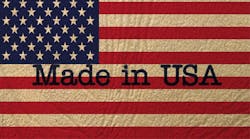Reshoring is delivering wide-ranging benefits for an increasing number of U.S. manufacturers, who see it as a way to maintain (or regain) global competitiveness. According to the Reshoring Initiative, in 2003 about 140,000 jobs were lost to offshoring. In 2014, for the first time in two decades, the U.S. realized a net gain of 10,000 reshored jobs.
I expect to see more deep drawn reshoring in particular, because Boston Consulting Group predicts fabricated metal products will be one of the top sectors to benefit from this growing trend. In fact, the Reshoring Initiative says through 2014, 30 companies in this sector have already restored 1,721 jobs to American soil.
During the late 20th century, manufacturers saw financial salvation in moving production facilities overseas. They saw the lower cost of labor and processing, and at the time, lower material costs.
But, as so many American manufacturers have seen, the lower price tag came at a cost.
Times have changed, and not just economically. Wages in Asia have risen dramatically in recent years, especially in China, reducing or virtually eliminating any cost advantage. Meanwhile, lengthy supply chains eat up time and expose companies to multiple vulnerabilities from inconsistent product quality to costly port slowdowns. The lower material costs that many countries could boast was due to lower quality materials. With our high quality standards, those countries just can’t get away with that anymore. As we’ve seen for many back home, offshoring has lost its luster.
One of the drivers of reshoring I find most interesting is actually China’s booming infrastructure. Previously, people simply could not travel easily, so they stayed where they were and worked. Now, ease of travel enables workers to relocate to areas that pay more money, drying up labor wells in the low-cost parts of the countries. In turn, this has created higher labor costs and more service and quality issues. Offshoring doesn’t provide value anymore.
In fact, the opposite is true- companies with operations remaining overseas are hurting. Consider higher labor costs, higher transportation time and costs, poor quality, higher shipping risk, and the emergence of port strikes. Weak engineering services are getting weaker, and workers are moving to more glamorous service jobs.
That’s not to mention the intangibles- travel, minimum order requirements that increase inventory and affect cash flow, late deliveries, poor communication, long response time. Companies are also concerned that environmental and social issues surrounding foreign production facilities are damaging their reputations.
American manufacturers once saw their streets paved with gold by keeping their work off their own streets. Now that picture is bleak. So what are companies to do? As we’ve been seeing in mass numbers, bring the business back home.
Reshoring is reopening doors for U.S. manufacturers. Bringing jobs and production facilities back home increases agility and shortens lead times, enabling companies to reduce inventories yet still meet fluctuating delivery requirements and respond quickly to customer needs. After being in this business a while, I can tell you that companies want to be physically closer to suppliers, not just to tighten the supply chain but to facilitate more collaborative working relationships.
Reshoring allows companies to take advantage of tax incentives, have skilled workers available and innovate while protecting intellectual property. For some, the ability to operate facilities using inexpensive natural gas now makes U.S. locations far more cost-effective than foreign countries where electricity and coal are considerably more expensive. Eliminating import duties and reducing transportation costs can also improve profitability, enabling manufacturers to lower product prices or finance new R&D.
And I don’t have to explain the resurgence of pride that comes with the Made in USA label. In short, manufacturers are looking at the total cost of off- versus reshoring and seeing greater ROI on the home side. And so the tide has turned.
Hundreds of companies in dozens of states are already reshoring. The vast majority of those jobs have returned from Asia, primarily China, though a significant number have returned from Mexico and other countries. States that are the biggest winners thus far in terms of job increases are:
- South Carolina – 7,780
- Michigan – 6,721
- California – 6,014
- Kentucky – 4,612
- Texas – 3,712
So what does the future hold? Most industry watchers agree with me that the trend toward reshoring is just getting started. We expect the U.S. to produce more manufactured goods domestically in the coming years, and manufacturers will continue to reassess their individual circumstances in light of the latest global conditions and domestic opportunities. Harry Moser, founder and president of the Reshoring Initiative, points to the fact that somewhere between 3 and 4 million jobs remain overseas as an indicator of reshoring’s potential.
Beyond precision metal fabricators and their customers that can benefit specifically from deep drawn reshoring, manufacturing in general can reap comprehensive financial and reputation management benefits from this trend. And our country as a whole stands to gain as well, through increased employment, a reduced trade deficit and greater overall economic sustainability.
Rich Regole is the president and CEO of Accurate Forming, a leader in the art and science of deep-draw metal forming. Accurate Forming supplies complex deep drawn components and value-added operations such as in-house polishing, nickel & chrome plating, high performance powder coating, notching, slotting, thread rolling, and assembly.




